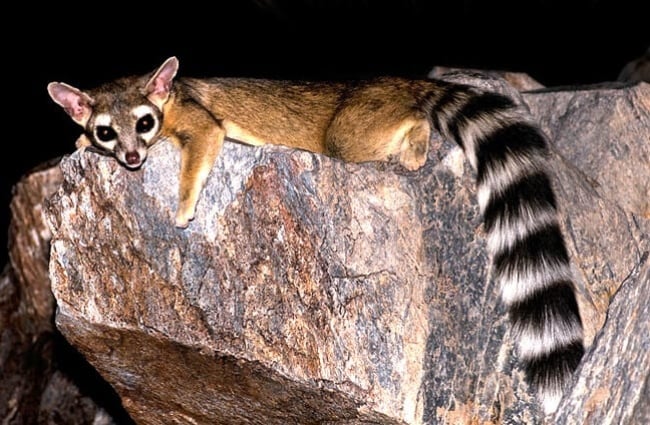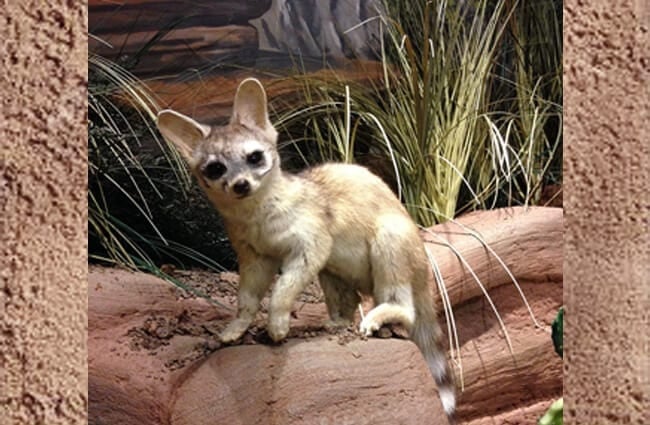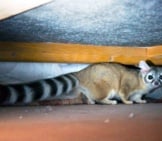Ringtails are cat-like mammals that are related to raccoons. Many people also call them “ringtail cats,” “ring-tailed cats,” “bassarisks,” and “miner’s cats.” While they are not genetically related to cats, they do look quite similar to felines. Instead, ringtails are in the Procyonidae family, along with raccoons, kinkajous, coatis, and olingos. Read on to learn about the ringtail.
Description of the Ringtail
These cat-like mammals have buff-brown fur, with relatively large ears, and a long tail. As their name suggests, their tail has black and white rings, much like raccoons and coatis have.
Their tail is usually just as long as their body, between 12 and 17 in. long. With body and tail combined, ringtails measure around 24 – 34 in. long. However, they are lean creatures, and typically weigh around 2 lbs.
Interesting Facts About the Ringtail
Ringtails are interesting looking creatures, with interesting behavior and traits. There are a number of different fun facts about ringtails, read a few below!
- Miner’s Cat – One of the more unusual nicknames of the ringtail is the miner’s cat. During the 1800s, miners in Arizona and California commonly kept these creatures as pets. Apparently, the miners were quite fond of their ringtail companions because they were wonderfully efficient mouse catchers!
- Musky Mouthful– Ringtails are usually smaller than the average housecat, and half of their length is tail alone. Because of this, they commonly fall prey to many different predators. To avoid becoming lunch, ringtails excrete a strong-smelling musk when startled. This musk confuses and deters many different predators.
- Cat-Like Climbers – Ringtails may look a little like cats, but they sure can climb better than most housecats! They can rotate their ankles over 180º, which allows them to climb up and down trees easily. Ringtails can even change direction on a branch by doing a cartwheel!
- Striped Tail – This mammal’s long tail is not just for show. While their tail is not prehensile, and they cannot use it to grip branches, it is still quite useful. Ringtails use their tails to help them balance while climbing. Because their tail is so long, it works very efficiently as a counterbalance.
Habitat of the Ringtail
While these creatures live in a few different types of habitats, they live in arid environments most frequently. Rocky deserts are their favorite, but they also live in desert-like habitats near water sources. In these ecosystems, they nest in abandoned structures, mineshafts, hollow trees, caves, and more. These mammals also live in pine, conifer, and juniper forests with low rainfall.
Distribution of the Ringtail
Ringtails live in the Southwestern United States and across Mexico. Populations live in southern Oregon, California, Arizona, New Mexico, Nevada, Utah, Colorado, parts of Kansas, and Texas.
Its range in Mexico is from the United States border south to Oaxaca. They are widespread in Mexico, but their distribution in the northern ends of their range is rather spotty.
Diet of the Ringtail
Ringtails are omnivores, but most of their diet consists of animals rather than plants. Their primary prey includes mice, rats, rabbits, ground squirrels, insects, and other small mammals.
Some less common food sources include fish, snakes, birds, lizards, and carrion. They also eat fruit, and some of their favorites include prickly pear, juniper, blackberries, hack, persimmon, and more. Their diet changes based upon the availability of food, for example, when mice are plentiful, they eat more mice.
Ringtail and Human Interaction
Humans and ringtails actually lived quite harmoniously. Because miners recognized their ability to catch mice and other pests, they often kept the creatures as pets.
Nowadays, it is illegal to own a ringtail as a pet without proper permits, though humans still acknowledge them as pest control. As with any animal, habitat destruction can be a problem, but their population is stable. The IUCN lists these animals as Least Concern.
Domestication
Though humans commonly kept these creatures as pets, they never formally domesticated ringtails.
Does the Ringtail Make a Good Pet
Ringtails did make good pets to miners, but that was because there were plenty of vermin for them to hunt. In a typical household, ringtails would not make good pets, simply because there wouldn’t be enough for them to do.
These creatures are wild animals, and when miners kept them as pets, they slept during the day, and hunted for vermin at night. Their relationship was really more of a partnership than anything. The miners provided safe nests to sleep in, and the ringtails hunted the pesky mice.
Ringtail Care
In zoos, ringtails need a little more stimulation, because they can’t exactly let them out to hunt mice at night. Instead, the zookeepers give the little predators a variety of puzzles, new scents, and fun toys, as well as training them using positive reinforcement.
These animals eat a diet of small mammals, like mice, rats, rabbits, and more. Because their natural diet also contains fruit, zookeepers give them a variety of fruits as treats. Their habitats have plenty of hiding places, and a variety of objects to climb and exercise on.
Behavior of the Ringtail
These little mammals are relatively similar to their raccoon cousins. They are nocturnal and active at night, and live alone. Unlike raccoons, ringtails are relatively shy, and avoid human contact.
Rather than roaming suburbs for garbage, these creatures actively spend their nights hunting small prey. They spend the rest of their time marking the boundaries of their territories. Males and females have overlapping territories, but they rarely interact outside of breeding season.
Reproduction of the Ringtail
Females are only receptive to mates in the spring. After mating, the male brings the female food during her 45 – 50 day gestation period. The female usually gives birth to 2 – 4 offspring, called “cubs.”
It takes a month for the cubs to open their eyes, and they will not learn to hunt until they are 4 months old. Once the cubs are 10 months old, they can reproduce themselves, and leave their mother.







![Red Angus Closeup of a beautiful Red Angus cowPhoto by: U.S. Department of Agriculture [pubic domain]https://creativecommons.org/licenses/by/2.0/](https://animals.net/wp-content/uploads/2020/03/Red-Angus-4-238x178.jpg)












![Red Angus Closeup of a beautiful Red Angus cowPhoto by: U.S. Department of Agriculture [pubic domain]https://creativecommons.org/licenses/by/2.0/](https://animals.net/wp-content/uploads/2020/03/Red-Angus-4-100x75.jpg)

